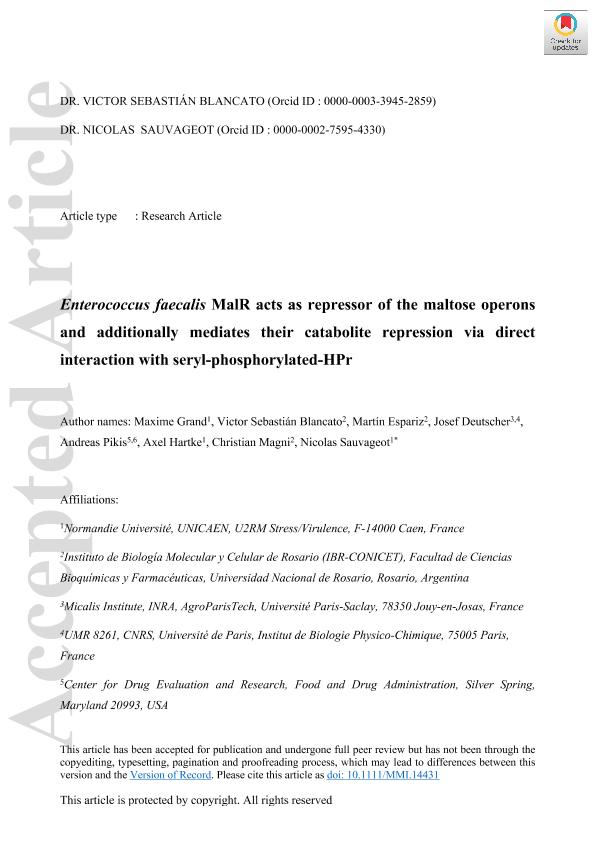Artículo
Enterococcus faecalis MalR acts as a repressor of the maltose operons and additionally mediates their catabolite repression via direct interaction with seryl-phosphorylated-HPr
Grand, Maxime; Blancato, Victor Sebastian ; Espariz, Martin
; Espariz, Martin ; Deutscher, Josef; Pikis, Andreas; Hartke, Axel; Magni, Christian
; Deutscher, Josef; Pikis, Andreas; Hartke, Axel; Magni, Christian ; Sauvageot, Nicolas
; Sauvageot, Nicolas
 ; Espariz, Martin
; Espariz, Martin ; Deutscher, Josef; Pikis, Andreas; Hartke, Axel; Magni, Christian
; Deutscher, Josef; Pikis, Andreas; Hartke, Axel; Magni, Christian ; Sauvageot, Nicolas
; Sauvageot, Nicolas
Fecha de publicación:
11/2019
Editorial:
Wiley Blackwell Publishing, Inc
Revista:
Molecular Microbiology
ISSN:
0950-382X
Idioma:
Inglés
Tipo de recurso:
Artículo publicado
Clasificación temática:
Resumen
Enterococci are gram-positive pathogens and lead to cause hospital-acquired infections worldwide. Central carbon metabolism was shown as highly induced in Enterococcus faecalis during infection context. Metabolism of α-polysaccharides was previously described as an important factor for host colonisation and biofilm formation. A better characterisation of the adaptation of this bacterium to carbohydrate availabilities may lead to a better understanding of the link between carbohydrate metabolism and the infection process of E. faecalis. Here we show that MalR, a LacI/GalR transcriptional regulator, is the main factor in the regulation of the two divergent operons involved in maltose metabolism in this bacterium. The malR gene is transcribed from the malP promoter, but also from an internal promoter inside the gene located upstream of malR. In the absence of maltose, MalR acts as a repressor and in the presence of glucose, it exerts efficient CcpA-independent carbon catabolite repression. The central PTS protein P-Ser-HPr interacts directly with MalR and enhances its DNA binding capacity, which allows E. faecalis to adapt its metabolism to environmental conditions.
Palabras clave:
METABOLISM
,
MALTOSE
,
ENTEROCOCCUS
,
REGULATION
Archivos asociados
Licencia
Identificadores
Colecciones
Articulos(IBR)
Articulos de INST.DE BIOLOGIA MOLECULAR Y CELULAR DE ROSARIO
Articulos de INST.DE BIOLOGIA MOLECULAR Y CELULAR DE ROSARIO
Citación
Grand, Maxime; Blancato, Victor Sebastian; Espariz, Martin; Deutscher, Josef; Pikis, Andreas; et al.; Enterococcus faecalis MalR acts as a repressor of the maltose operons and additionally mediates their catabolite repression via direct interaction with seryl-phosphorylated-HPr; Wiley Blackwell Publishing, Inc; Molecular Microbiology; 113; 2; 11-2019; 464-477
Compartir
Altmétricas



